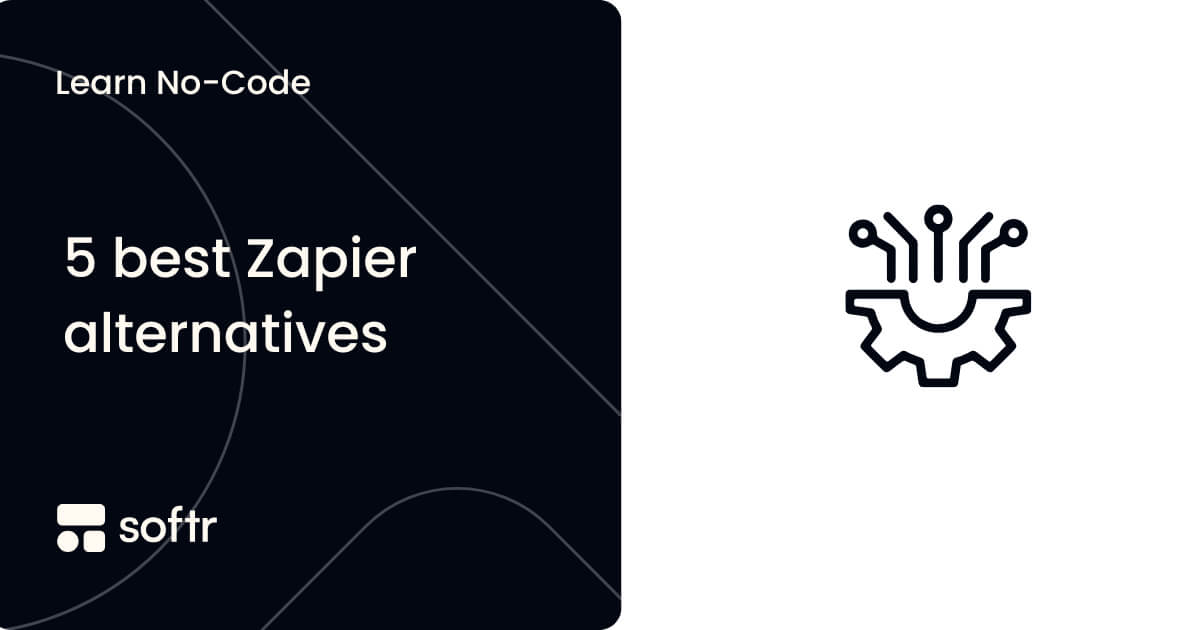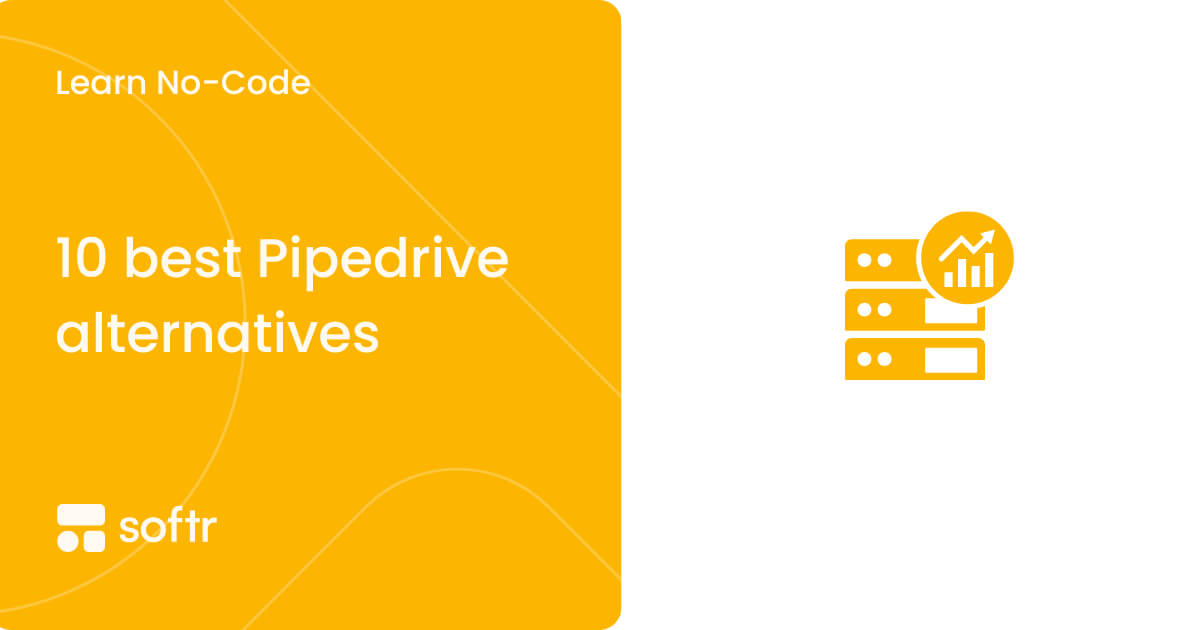8 Webflow alternatives hand-picked to help you find the perfect match

You want to build an intuitive website but don’t have time to spend learning the intricacies of a complex tool. You need a no-code solution that’s quick and easy to use.
The first tool that comes to mind is Webflow. But it has a steep learning curve and like all other things, it has its drawbacks.
For example, Webflow isn’t designed for beginners and can get too complex. And if you’re looking to build a website, ecommerce platform, or internal tool without a background in tech, Webflow may not be your best bet.
To help you more easily build a powerful website, we’ve compiled a list of 8 Webflow alternatives that are either more affordable, easier to use, or both.
What is a website builder?
If you wanted to build a website in a world without no-code website builders, you’d have to hire a team of developers, designers, and marketing experts, and go through months of back and forth to finally nail a final version of your website. This process is, more often than not, really costly.
If you’re short on resources, need a quick solution or simply don’t have access to a dev team, you can use a website builder. Website builder software exists to make your job easier—it costs less than building web applications from scratch, and it’s usually quicker and often beginner-friendly.
Instead of hiring a developer to make your website, the platform’s interface makes it easier for you to assemble one. A lot of them are no-code or low-code, so you can build a website without prior coding experience or with minimal coding.
Which is the best website builder on the market?
The perfect website and web app builder depends on various factors like the use case, your tech background, and budget. A platform that’s perfect for a freelancer to build their portfolio on may not be the best one for a large enterprise creating an internal platform. That’s why before choosing a platform, you’ll need to get crystal clear on your budget, use case, needs, and expectations.
8 Webflow alternatives to look out for in 2023
We’ve selected 8 no-code and low-code website and web app builders that let you create websites with varying levels of flexibility, design, and functionality, including:
- Softr - best all-in-one solution for medium and small businesses
- WordPress.org - best open-source website builder
- Squarespace - best for portfolios
- Wix - best for beginners
- GoDaddy - best for bulk domains
- Square E-Commerce (formerly Weebly) - best value for money
- Shopify - best for e-commerce
- Zyro - best for affiliate marketing
Let’s look at their individual features, drawbacks, pricing and ratings.
Softr: best all-in-one solution for medium and small businesses

Softr is a no-code web app builder with a relatively shallow learning curve, that offers custom domains and a large repository of templates you can use to build websites, landing pages, and internal tools like client portals and CRMs.
And while users need to integrate Webflow with third-party tools like Memberstack, along with various payment systems, to create membership websites and marketplaces, Softr provides membership functions out of the box, and a native Stripe integration that allows users to check their subscriptions or purchases directly from their profiles. Users can also add access rules based on user purchases and more.
Main features:
- Customized branding
- Content import & export
- Search and filters
- Video and image embedding
- Secure data
- SEO optimization
- Ready-made, customizable templates
- Payment, media, and analytics integrations
- Active community and 24/7 customer support
Drawbacks:
Softr offers limited scope for design customization. But for users that need a no-code tool that’s easy-to-learn, this helps eliminate decision overwhelm. Additionally, the tool can only integrate with Airtable and Google Sheets as data sources, as of now. But new integrations are coming soon!
Pricing:
- Free
- Basic - $49/per month.
- Professional - $139/per month.
- Business - $269/per month.
Critic's verdict:
Capterra: 4.7/5 (50+ reviews)
G2: 4.9/5 (30+ reviews)
For a more detailed comparison of the platforms, check out our Softr vs. Webflow overview.
WordPress.org - best open-source website builder

WordPress’s best feature is its very active community that is constantly working on releasing new plugins and themes and helping troubleshoot problems. Additionally, it’s extremely cost-effective and has a relatively straightforward interface.
For those with a developer background, the open-source quality of WordPress allows you to see the source-code and edit it according to your needs instead of being limited to the functionality provided, which is usually the case with other website builders.
Main features:
- Active and helpful community
- SEO friendly
- Expansive theme and plugin marketplaces
- Rollback versioning
- Built-in social sharing
- Automatic software updates
Drawbacks:
WordPress has a bunch of hidden costs, for things like themes and plugins, and accounting for them beforehand can be a problem. And if you’re looking to add more advanced functionality, WordPress can get too complicated to use and you might have to hire a developer to complete the task for you.
Additionally, the massive library of plugins and themes poses a security concern. In 2021, there was a 150% increase in WordPress vulnerabilities compared to 2020, and 29% of these vulnerable plugins were never patched. Two of these critical vulnerabilities were reported in plugins that were installed by over 1 million users.
The same study also found that in 2021, 99.42% of vulnerabilities came from plugins and themes, and 91% of vulnerable plugins and themes were free.
In short, this means that if you’re using WordPress due to its affordability, remember that you’re highly likely to have more costs associated with applying firewalls and protecting your customers further down the line.
Pricing:
WordPress.org is free. But, domain name, hosting, themes, and plugins can cost money. They can also push the costs higher than any other tool on the list, it all depends on how you use it.
Critic's verdict:
G2 - 4.4/5 (8300+ reviews)
Capterra - 4.6/5 (13900+ reviews)
Squarespace - best for portfolios

Squarespace boasts the best design tools and capabilities among the other platforms on this list. It’s affordable for solo creators and entrepreneurs, and also offers unlimited storage space. Its SEO tools also help with discoverability.
Main features:
- Secure socket layer (SSL) certificate
- Award-winning customer support
- 110+ mobile-responsive templates
- Reporting and analytics
- Social media integrations
- What You See Is What You Get (WYSIWYG) editor
- SEO optimization
Drawbacks:
Squarespace offers the best-designed templates but in terms of functionality, there could be improvements. The ready-made templates offer a lot of room for design customizations but adding new pages, setting up a blog or making minor tweaks to the back-end can take a lot of effort. It also requires you to manually save your work, doesn’t offer a free plan, and isn’t particularly scalable.
Pricing:
- Personal - $16/per month.
- Business - $23/per month.
- Basic Commerce - $27/per month.
- Advanced Commerce- $49/per month.
Critic's verdict:
G2 - 4.4/5 (980+ reviews)
Capterra - 4.6/5 (2400+ reviews)
Wix - best for beginners

Wix is an excellent Webflow alternative for beginners because of how intuitive the platform is and how easy it is to get started. Wix offers 800+ customizable templates, great business features (SEO, app market tools), and a shallow learning curve.
Main features:
- Velo (Wix’s visual builder)
- Password-protected pages
- WYSIWYG editor
- 800+ templates
- 600+ apps and extensions
- Free hosting for all plans
- SEO tools - (bulk 301 redirects, custom meta tags, etc)
- Logo maker
Drawbacks:
If you’re looking to build and capitalize on a website for the long-term, you’ll likely run into trouble with Wix’s SEO capabilities. While the tool offers access to an SEO Wizard, its techniques are elementary and rather behind the times. Without proper SEO functions, your website might have trouble getting indexed by or ranking highly on Google, which means less discoverability for your business.
Additionally, Wix doesn’t allow users to connect analytics and tracking tools like Google Analytics on their free plan. In order to see how well your website is performing, you’d need to upgrade your plan.
Pricing:
- Free - $0
- Combo - $16/per month.
- Unlimited - $22/per month.
- Pro plan- $27/per month.
- VIP plan - $45/per month.
Critic's verdict:
G2 - 4.2/5 (1400+ reviews)
Capterra - 4.4/5 (8700+ reviews)
GoDaddy - best for web host and domain registration

GoDaddy specializes in offering users everything they need to create their online presence. This includes a drag-and-drop website builder, hosting plans, domains, a professional email, and SEO tools. And if you’re managing a large number of domain names, this is a great tool as it keeps everything organized and on the same platform.
If torn between Squarespace and GoDaddy, compare features, customization, pricing, and user reviews in detail before deciding. For a deeper comparison, head over here.
Main features:
- Artificial Design Interface (ADI) editor
- Analytics and reporting
- SSL security
- Auto-save and backup
- Industry-specific templates
- 8000+ stock photos
Drawbacks:
GoDaddy is designed to cater to basic needs with their done-for-you templates. But since it uses ADI, it offers limited scope for design customization and flexibility. The block features are restrictive and the websites aren’t always appealing.
Also, once you upgrade to a paid plan, you can’t go back to the free one. It also has a bunch of hidden costs tucked away in the fine print—the ability to connect to a custom domain (this means it lets you connect to one but doesn’t offer you a free one) and the Microsoft 365 business email address that is only free for a year.
Pricing:
- Basic - $9.99/per month.
- Premium - $14.99/per month.
- Commerce - $16.99/per month.
- Commerce Plus - $29.99/per month.
Critic’s verdict:
G2 - 3.9/5 (110+ reviews)
Capterra - 4.1/5 (1000+ reviews)
Square E-Commerce (formerly Weebly) - best value for money

While Square is not as affordable as other ecommerce builders like Zyro and IONOS, it’s a more comprehensive tool. It offers all the basic ecommerce platform features (like site analytics, content management, etc) and is pretty beginner-friendly. It may not be the star of the show, but it sure is a cheap alternative.
Main features:
- SSL security and password-protected pages
- Unlimited storage (for premium plans)
- Drag and drop builder
- Advanced animation effects
- Custom fonts
- Custom HTML/CSS and JavaScript
- Video background
Drawbacks:
One of the main drawbacks of Square as an ecommerce platform builder is that it doesn’t offer a wide range of payment processing options. Your only choices as a user are Square, or PayPal if you have a Performance or Premium plan.
Finally, it also doesn’t offer a lot of advanced marketing tools, has limited plugin options, and comparatively fewer design options.
Pricing:
- Free - $0
- Connect - $5/per month.
- Pro - $12/per month.
- Business - $25/per month.
Critic's verdict:
G2 - 4.2/5 (430+ reviews)
Capterra - 4.3/5 (1680+ reviews)
Shopify - best for e-commerce

Shopify has multiple advanced inventory management, accounting, and analytics & reporting features designed to enhance sales. This makes it the perfect Webflow alternative for creating an e-commerce platform. Many users migrate their store from other platforms such as Magento to Shopify because of its ease of use.
Main features:
- 6000+ apps in the app store
- Multi-channel integrations
- Themes
- Stock images library
- Abandoned cart saving feature
Drawbacks:
One of the main drawbacks on Shopify is that sometimes, it feels like you have to pay for every little thing. For example, integrating with third-party payment gateways, apps, and plugins for added functionality requires recurring monthly payments. Additionally, some of these plugins are developed by independent developers and come with varying degrees of quality and customer support.
Also, Shopify is designed to cater to users that want to build and run an ecommerce platform, so if that’s not what you’re after, you’re better off with another tool.
Pricing:
- Basic Shopify - $29/per month.
- Shopify - $79/per month.
- Advanced Shopify - $299/per month.
- Shopify Plus - starting at $2000/per month.
Critic's verdict:
G2 - 4.3/5 (4000+ reviews)
Capterra - 4.5/5 (5500+ reviews)
Zyro - best for affiliate marketing

Zyro offers an in-app logo and slogan maker, and integrates with Unsplash to provide a wide selection of free stock images. This makes the tool extremely useful for people who need to roll out a professional-looking website quickly. It also has multiple AI-powered tools (like the heatmap and content generator) and over 100 templates with a robust drag-and-drop editor.
And finally, if you’re using Zyro to build an ecommerce platform, you’ll be happy to know that this tool doesn’t charge transaction fees or sales commissions, as well as offering one of the cheapest pricing plans.
Main features:
- Free domain for a year (after which it auto-renews at standard rate)
- Free web hosting
- SEO optimization
- SSL security
- Custom favicon
- Unique AI tools (like AI heatmap)
Drawbacks:
While Zyro is cheap, it doesn’t offer a free trial and plan. It has limited image editing options and doesn’t let you switch templates without losing all your content. The AI content generator offers basic capabilities and produces generic content.
Pricing:
Zyro has frequent sales and discounts so the prices may vary. At the time of writing this article, the website plan is $2.69/per month. The business plan is$3.59/per month. and the advanced store plan is$14.39/per month. If you factor in the frequent discounts, it’s the cheapest web builder on this list.
Standard rates:
- Website - $11.99/per month
- Business - $14.99/per month.
- Advanced store - $39.99/per month.
Critic's verdict:
G2 - 4.6/5 (30+ reviews)
Capterra - 4.7/5 (300+ reviews)
The best website builder for you
Building websites, especially for beginners, can be a long-drawn and taxing process. Web design software makes creating websites a rather seamless task. But, the question remains: which is the best website builder for you?
As you might’ve figured, there is no one ‘best’ tool that solves all your website building problems. But, if you know what you’re looking for and the features that serve you best, you’re already halfway there. If you want the best-looking websites, use Squarespace. If budget is a concern, use Zyro, Weebly, or WordPress. If you want flexibility, stick to Webflow.
But if you want to create powerful websites, web apps, and internal tools, Softr is the way to go. Whether you want to build a member-only website with our membership website builder or an SEO optimized website with our website builder for SEO, Softr provides an easy-to-use and affordable solution.
Frequently asked questions about Webflow alternatives
Do professional web designers use Webflow?
Yes, Webflow is used by web designers. It is designed for users that don’t want to dive too far into the world of code but have professional skills to customize websites. Because Webflow requires users to understand basic HTML and CSS concepts, designers and front-end developers with a history of working with some code adapt quickly to Webflow.
Which is better: Wix or Webflow?
Webflow offers flexibility and high-level customization but is harder to learn and requires a few technical skills. Wix on the other hand offers ease of use with no learning curve but has limited customization and lacks functionality.
What is the difference between Webflow and WordPress?
Webflow lets users build custom websites with a drag and drop builder and allows customizations on both the front-end and the back-end. It’s a no-code platform but has a steep learning curve. WordPress on the other hand is an open-source content management system (CMS) and users can use its extensions (themes and plugins) to build websites.
Is Webflow or Squarespace better?
If you want a web design software that offers more functionality and customizations to the front-end and back-end, Webflow is your best bet. If you want to create beautiful websites and want to use pre-existing templates to customize the front-end, Squarespace is for you. Webflow also has a steeper learning curve whereas Squarespace is comparatively easier to use.
How much does Webflow cost?
Webflow offers multiple pricing plans, starting with a free plan that includes a webflow.io domain, 50 CMS items, and 1 GB bandwidth. The paid plans include a bunch of other features are priced as the following:
- Basic - $12/per month.
- CMS - $16/per month.
- Business - $36/per month.
- Enterprise - contact Webflow








